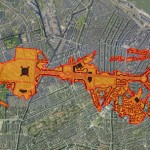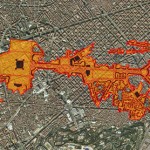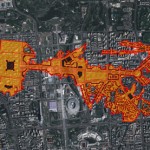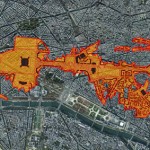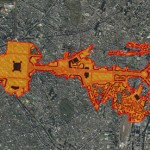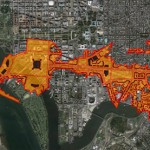Barcelona’s La Rambla is split in about three places. Half of the medieval centre disappears.
Cerdà’s extension loses, as percent, fewer surfaces, but it’s enough to have no kind of continuity and stop working as an urban system. Right behind this mad axis and the concrete curtains, fragments of blocks from the famous grid or of the historic fabric are left.
In Paris, the monster spares Notre-Dame, thr Louvre and the Arch of Triumph (yet without the Champs-Elysees). Instead, it crosses unmercifully the Northern area of the city and divides most boulevards.
The two plans only show one placement option each. One can move, decide what to keep, what to eliminate; the effects can be a lot more or less serious, but they will never go unnoticed.
What authors say
Bogdan Ilie is an architect and M.A. student in urban and strategic planning. Dan Achim is a IT engineer. They are childhood friends and passionate about their city, Bucharest.
“The identity of the city is also shaped by its socialist past, with which most of the locals are not satisfied. The last chapter of that era left us a megalomaniac ensemble pompously called “the Victory of Socialism”, whose logic and hierarchy totally contradict the structure and the values of the pre-existing city. This ensemble aimed to be the beginning of a new city, based on a
North-Korean vision on modernity, and, to make room for it, old Bucharest had to sacrifice a section having the size of Venice.
We started from the question “OK. It is big. But, how big is it?” For us, it was an interesting challenge, especially given that we are trained in various subjects and communicate ideas in different languages. This very difference helped us find a simple, interactive and dynamic way, we think, to be able to see the impact this project could have had in other backgrounds. We grew together, wandering the streets of Bucharest, whom we managed to value and take it as it was, with its good and bad points. We try to understand best, and through this project and other potential future projects, we try to support this search of identity.” (Bogdan Ilie, Dan Achim)
An urban totalitarian module
Portmanteau.ro is as simple and attractive to be understood, as it is impressive an integrated platform with Google Maps, to help overlap the scaled plan of the 80s totalitarian operation over a city you pick. If you wish, you can go for the random succession (jumping from megalopolises to idyllic towns is truly something). A small bulldozer helps walk the unwanted guest anywhere on the territory of the selected town. Somehow, you can measure and compare cities with the help of a totalitarian module.
The project, carried out completely by voluntary work, is meant to support remembering and raising awareness. Beyond the case of Bucharest though, this seems interesting as an instrument of cross-disciplinary research and as a cultural assignment: it makes you, apparently in a playful way, to reflect about urbanism, responsibility, solidarity and common identity.
This article was published in Zeppelin no. 113 / April 2013
Text: Stefan Ghenciulescu + Bogdan Ilie, Dan Achim

